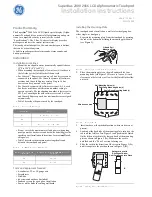
18
19
INSTALLATION AND OPERATION MANUAL SOLAR MODULES Q.MAXX-G2 – Q CELLS
INSTALLATION AND OPERATION MANUAL SOLAR MODULES Q.MAXX-G2 – Q CELLS
18
19
Protective Grounding
Ä
The modules must be grounded in accordance with the local
statutory regulations.
Functional grounding
•
For installations located in tropic regions (between 23.5° N
and 23.5° S) with a module tilt of < 5°, functional grounding
at the negative generator connection on the DC side must
be implemented.
Ä
Ensure that the difference of potential between the nega-
tive generator connection and the local earth potential (e.g.
substructure, PE of the inverter) on each string in operation
mode is positive or 0 V.
Ä
Follow the directions of the inverter manufacturer and local
statutory regulations.
Ä
Only use inverters which include lincensed grounding kits.
Ä
Functional grounding has also to be implemented in instal-
lation sites with increased salt content in the air. (e.g. close
to the sea).
DANGER!
Risk of fatal injury due to electric shock!
Ä
Do not attempt to fix any problems yourself (e.g., glass cracks,
damaged cables).
Ä
Please contact an installer or Q CELLS Technical Customer
Service Department.
Ä
Do not disconnect modules by yourself.
Ä
Please contact an installer or Q CELLS Technical Customer
Service Department.
Ä
Dispose of modules in accordance with the local disposal
regulations.
Q CELLS solar modules are known for a long operating life and
minimal maintenance effort and expense. Dirt and grime are
usually washed away by rain. If the module is fully or partially
shaded by dirt or debris (e.g., plants, bird droppings), it needs
to be cleaned to prevent a loss of performance.
Maintenance
Ä
The PV system has to be inspected regularly by certified
personnel
Ä
The time intervals and extent of the inspection can depend
on local circumstances (e.g. salt, ammonia content in the air,
high humidity etc.). The customer/operator must inform himself
about time intervals and extend of necessary inspections.
Ä
Inspections have to be performed especially after extraordinary
events (e.g. storm, hail, high snow loads etc.)
Ä
During the inspections it has to be checked that the compo-
nents are secure, undamaged and clean
Cleaning
WARNING!
Risk of injury due to hot and live modules!
Ä
Only clean modules that have cooled down.
Ä
Do not carry or wear any electrically conductive parts.
WARNING!
Risk of falling due to unsecured access!
Ä
Never access the installation area alone or without taking
adequate security precautions.
Ä
Please commission a trade specialist.
NOTE!
Module surface damage may occur!
Ä
Remove snow and ice carefully without force (e.g. with a
very soft broom).
Ä
Do not scratch off dirt.
Ä
Rinse dirt (dust, leaves, etc.) off with lukewarm water or use an
alcohol based glass cleaner. Do not use abrasive detergents
or surfactants.
Ä
Use a soft cellulose cloth (kitchen roll) or sponge to care-
fully wipe off stubborn dirt. Do not use micro fleece wool or
cotton cloths.
Isopropyl alcohol (IPA) can be used selectively to remove
stubborn dirt and stains within one hour after emergence.
Ä
Please follow the safety guidelines provided by the IPA
manufacturer.
Ä
Do not let IPA run down between the module and the frame
or into the module edges.
NOTE! Module damage may occur!
Ä
Do not clean modules with water if there is a
risk of frost.
0°
5 GROUNDING
6 FAULTS AND DEFECTS
7 DISPOSAL
8 MAINTENANCE AND CLEANING
Ä
Free the substructure from any dirt and debris
(leaves, bird nests, etc.).
Ä
Remove dirt with lukewarm water or alcohol
based glass cleaner, a broom, or a soft cloth.
Ä
Do not use surfactants, rotating brushes,
scrapers, or any high-pressure water cleaning
equipment.





























